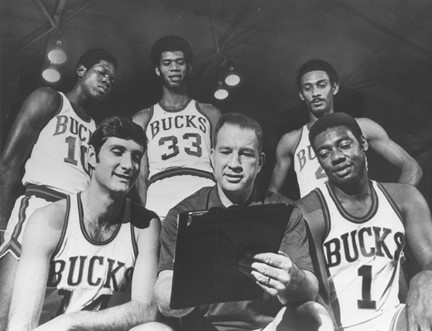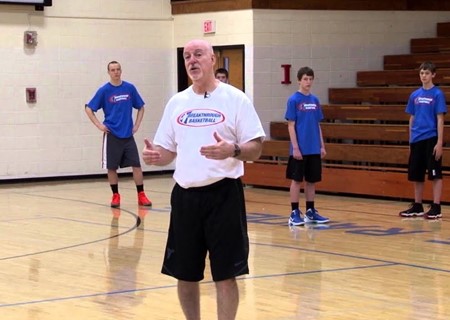Scouting: Stop Reinventing Your Team For Every Opponent
You are preparing for your season. You have chosen your team. You have made your schedule. You have installed your offense and your defense. What do you do next?
I have always believed that scouting your opponents is the lifeblood of a successful season.
Once you have chosen your team, you are pretty much locked in with your talent level. You shouldn't change your offense or defense too much from game to game.
What is it that is going to create an equalizer against better players and allow you to pull away from lesser teams?
I believe that is game planning. In order to game plan, you need to have a pretty good idea of what the other team is about. And, you need to know what to present and how to present it to your team.
I have gone through many iterations of how I scout other teams. I started out working in the blind.
The Scouting Legend Larry Costello
How to scout is an area that often gets overlooked when you prepare to be a coach. I started out just by writing down offensive and defensive plays and describing personnel.
Larry Costello started playing in the NBA in the mid-1950's. During his playing career, he was a 6 time All-Star and was the point guard for the 1966-67 Philadelphia 76ers, who won the NBA Championship with Hall of Fame players Wilt Chamberlain and Hal Greer.
After retiring as a player, he went into coaching and coached the Milwaukee Bucks, with Lew Alcindor (you might know him as Kareem Abdul-Jabbar) and Oscar Robertson to their first NBA Championship. After Milwaukee, he coached the Chicago Bulls, with Jerry Sloan as his point guard.
Costello left the NBA to Coach Utica College in upstate New York, which is where I met him. I was coaching at Marist College at the time and we played a lot of common opponents so I got to see and speak with him a lot.

Larry Costello with his 1971 NBA Championship team, the Milwaukee Bucks
Source: Milwaukee Journal Sentinel
The 35-Page Scouting Form
Costello was important to me because he changed my focus on how to scout and how to prepare for opponents. In our discussion about scouting, he gave me one of his scouting forms.
It was like a book. I think it was 35 pages in all. He developed it so his assistants, who did the scouting, would know what he thought was important in preparing for their games and all his assistants gave him an organized report and he knew where to look for the information.
One of the interesting things about this form is that it was all question and answer. He wanted the scout to know exactly what information he wanted and what to look for. 35 pages seemed like a lot, but I learned as I went along in my career, it really wasn't.
More importantly, the organization and consistency made scouting much easier for me. It addressed things that I never thought of, such as:
- Who switches and who doesn't
- Who guards the wing in their zone
- How do they play block-to-block screens; how do they play “like” players
- What defense do they play after time outs
- Do they run particular plays after they call timeout
- When do they change defenses etc.
I found it fascinating. It started me thinking in different directions than I had thought of in the past.
As I moved on in my career, I worked for several more head coaches, all had their own ways of looking at scouting and had different needs and requirements.
Does Being Too Prepared Cause Problems For Players?
One coach I worked for has to be the best preparation coach I have ever seen. The adjustments he would make, the way he predicted the game would unfold, the situations he saw that we needed to avoid or take advantage of were second to none.
He insisted on knowing everything possible about our opponent. Because I was one of his assistants, it was my job to give him what he wanted. It was better to give him too much information than not enough. It was not my job to decide for him what information he needed, it was my job to give him the information and allow him to choose. It was a lot of work.
My scouting reports for him were kept in loose-leaf binders and often contained over 100 pages. I watched every game that opponents played up to the time we played them.
I would watch a minimum of 6 games. If it were early in the season, I would watch all the games from the current season and multiple games from the previous season. It was not uncommon for me to watch a team play 25-30 times as we moved later in the season.
I would catalogue plays (offense and defense), situations, personnel and every other aspect of the game. When my work was done and 2 days before the game was to be played, I would present my scouting binder, a video of every game I have watched and a breakdown video that ordered offense, defense and personnel. He would then watch all the games and match it up to the scouting report.
When we presented it to the team, we would walk through every cut of every set our opponent had run and how we would play them. We would watch the breakdown video (20 minutes) and go over a 3 page written report that included offensive tendencies, defensive tendencies and personnel.
We were always prepared. Uber Prepared. Too prepared. So prepared that it was difficult for us to play well.
We played 31 games in a year and we had players that had trouble remembering what we were doing and we expected them to remember what our opponents were doing. It wasn't fair to our players.
They were loaded down with so much information that they couldn't play.
When Less Is More - What I Settled On For Scouting
Now, I think I come from a unique angle. I was an assistant for 8 years and then became a head coach. I was a head coach for 14 years and decided to go back to being an assistant again. The change in perspective was stark.
Going from trying to make my bones in the profession by impressing people with my work, to a position where I had to make decisions about effectiveness and efficiency and then back to a position where I had to assume someone else's priorities and think in someone else's voice was an experience.
I was finally able to convince him that, while he needed to satisfy himself in regard to preparation, we had to do a better job of preparing our players to play by not weighing them down with so much crap.
We discussed what I did for game preparation as a head coach and he bought in.
Here is what we did:
- While our head coach wanted to watch every game, we (the assistants) were mostly concerned with their last 3 games.
- We used Coach Costello's scouting form so we could determine common tendencies and incorporated them into our practices before the game (switching, left or right handed, pressure, man or zone, etc.)
- We learned the 4 or 5 offenses that they ran the most. We then worked really hard to disrupt the entry into those offenses and the next pass (Have you ever tried to continue your offense when your opponent won't let you enter? What did that do to your team?).
Everything else, we played according to our basic defensive principles that we practiced every day. - We did the same thing offensively. We found the 3 or 4 things they did the most defensively and made adjustments accordingly.
- We also sectioned off the schedule in groups of 4 games. So, effectively we scouted 4 teams at a time. Inside of each section, we looked for commonalities among the teams.
Did they switch on the perimeter, did they trap ball screens, did they run flex cuts, etc?
We would incorporate those commonalities into our practices during that period. That made it much easier for everyone to understand when we had preparation practice for our next opponent.
Nothing was new; we just had to place it inside our next opponent.
We stopped reinventing our team for every opponent. We did what we did best and matched it up against what our opponent did.
Our scouting sessions became very simple; scouting report, video, short walkthrough and that was it.
The results were staggering. Players played with more confidence and greater enthusiasm. We defended better, executed offense better and won more games.
Don't reinvent your team for every opponent.
Do what you do best...
and match it up against what your opponent does.
A National Champion Coach's Unorthodox Approach To Scouting
On the other hand, when I was a head coach, we had a coach in our league who scouted differently than anyone I have ever met...
He did not watch games and he did not watch film. Before the game, he would grab a copy of the stats and note the two players who took the most shots for their opponents. He didn't care about points or percentages, only who took the most shots.
In the first half they would guard those two players as if they were the only two players on the court. If other people shot, he really didn't care. All the while, he was watching HOW they got their shots.
At halftime, he would make adjustments in regard to patterns and other players that were hurting them. Then, in the second half, they would shut you down by stopping the shooters and disrupting patterns.
It seemed that all of their games were the same, close first halves and clamp down defensive second halves in which they would pull away.
The result was a National Championship. Their national championship final was typical of most of the games they played. At halftime, they were up 3. In the second half, in the first 10 possessions they forced their opponent into 3 missed shots and 7 turnovers. They went on a 17-0 run and became National Champions.
What's the point? Well, unless you coach at a higher level, you won't have the time, money or staff and access to information to really scout your opponents in depth. That doesn't mean you can't prepare.
Take note as to what your opponent does the most, find common threads, disrupt entries and make them beat you with someone other than their best player. That will prepare you for success.

Coach Don Kelbick
Coaching Resources From Don Kelbick
If you'd like to learn more from Don Kelbick, here are some coaching resources:
The Attack & Counter Skill Development System
Transition Offense and the Four-Second Fast Break
Continuity Zone Offense & Concepts To Beat Any Zone Defense
|
|||||||||||



 Facebook (145k Followers)
Facebook (145k Followers) YouTube (152k Subscribers)
YouTube (152k Subscribers) Twitter (33k Followers)
Twitter (33k Followers) Q&A Forum
Q&A Forum Podcasts
Podcasts